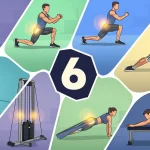Do you want to live a healthy life and choose the gym as your favorite place to exercise?
Starting out at the gym can feel like entering a new world full of terms you’ve probably never heard of before.
Don’t worry, we are here to help you understand these terms so you can feel more comfortable and confident.
When you first come to the gym, you may feel confused and a little awkward because of the foreign terms used.
Like other sports, the gym has its own vocabulary that is important to understand so you can train more effectively and safely.
However, there is no need to worry! You can recognize gym terms easily and over time, you will get used to hearing and using them.
It is important for you to understand these terms so that your training can be maximized and you can achieve your fitness goals more quickly.
Let’s discuss further what a gym is and some important terms you need to know as a beginner!
About Gyms
A gym is a sports place equipped with various physical training equipment and facilities, especially fitness equipment. The gym is also known as a fitness center, where everyone who comes has the aim of training physical fitness and fitness. Apart from that, the gym is a meeting place for people with various physical training goals, from weightlifting, martial arts, to general fitness.
Initially, the gym served as a place for physical training for those who had achievements in bodybuilding or other sports. However, as time goes by, gyms are now open to anyone who wants to maintain their fitness and health. Gyms provide facilities for a variety of physical exercises, which can help improve overall health and wellbeing.
By knowing and understanding the terms in the gym, you will feel more comfortable and confident when training. So, let’s start your fitness journey by getting to know some basic terms frequently used in the gym!
Gym Terms
1. Reps
Reps is an abbreviation of repetitions or repetition in Indonesian, which means repetition. Example: When your fitness trainer asks you to lift the dumbbells for 10 repetitions, it means you are asked to lift the dumbbells 10 times. The number of repetitions required for muscles to reach the hypertrophy point is 8-12 reps. If you can’t complete 8 reps, chances are the weight is too heavy. On the other hand, if you are able to complete more than 12 reps, it means the load is too light.
2. Sets
Sets are a collection of reps performed sequentially. If you do 10 push-ups, rest, then do 10 more push-ups, that means you have done 2 sets of push-ups. Sets help organize workouts in manageable segments and give muscles time to recover between workouts.
3. Barbells and Dumbbells
A barbell is a fitness tool in the form of a long iron rod that can be added to a weight at each end. Barbells are used to train strength, balance and stability. Dumbbells are a smaller version of the barbell, easy to use for a variety of movements, and ideal for working both sides of the body to maintain balance.
4. Pump / Pumping
Pump or pumping is the term used when the muscles feel bigger and harder after exercise. This occurs due to increased blood flow to the trained muscles. This effect is temporary and the muscles will return to normal size after some time.
5. Cardio
Cardio exercise is physical activity of moderate intensity over a long period of time, such as running, cycling or swimming. Cardio exercise increases stamina, burns calories, and supports heart health. Cardio can be done in the gym or outdoors.
6. Wet Muscles
Wet muscle is muscle that still has high fat content. Wet muscles look big but lack definition because they are covered in fat. A proper exercise program and diet can help reduce fat and increase muscle definition.
7. Dry Muscles
Dry muscle has a low fat content so the muscle looks clear and defined. To achieve dry muscle, consistent exercise and a low-fat diet are required.
8. Spot/Spotting
Spotting is the act of supervising and assisting a training partner to ensure safety and help complete sets without injury. The spotter holds the weight and is ready to help if needed, especially on the last rep.
9. Failure
Failure is the moment when you have to struggle hard to complete the last repetition when lifting weights. This is a sign of optimal training, indicating that the load is suitable for your abilities.
10. Bulking
Bulking is a phase to increase as much muscle mass as possible through weight training and a high-calorie diet. Bulking can be done by clean bulking (limiting calorie intake) or dirty bulking (without calorie restriction).
11. Cutting
Cutting is a phase to reduce body fat levels while maintaining muscle mass. In this phase, cardio training is increased and diet is strictly controlled to achieve defined muscles.
12. Cooldown
Cooldown is an activity done after exercise to stabilize the heart rate and help the body recover. Cooldown involves static stretching and light movement to return the body to normal condition.
13. Core Training
Core training involves the core muscles, namely the abdominal and lower back muscles. This exercise is important for body stability and preventing injury.
14. Repetition Maximum (RM)
Repetition Maximum is the maximum weight that can be lifted in one repetition. For example, if you can lift a 100 kg barbell only once, that means 100 kg is your 1RM.
15. Muscle Protein Synthesis
Muscle Protein Synthesis is the process in which protein is produced to repair muscle cell damage resulting from intense exercise. This process is important for muscle growth and recovery.
16. Supersets
Supersets are a training method in which two movements are performed sequentially without rest in between. Supersets increase training intensity and save time.
17. Dropset
Dropset is a variation of an exercise where the load is reduced gradually after each set until the muscle reaches the point of failure. Dropsets put new stress on the muscles to achieve hypertrophy.
18. Pyramids
Pyramid is a training program in which the load is increased gradually by reducing the repetitions with each set. This helps build muscle strength and endurance.
19. Full Range of Motion
Full Range of Motion is the full range of motion in an exercise, ensuring the muscles work optimally. For example, in the bench press, the barbell is lifted from above the chest all the way up and then lowered back down.
20. Overload
Overload is an exercise that forces a muscle to work beyond its capacity to increase strength and endurance. Ways to overload include increasing the load, repetitions, or reducing rest time.
21. Mind-Muscle Connection (MMC)
Mind-Muscle Connection is the process of providing conscious stimulation to certain muscles to maximize muscle contractions. Focusing on MMC helps increase exercise effectiveness and desired results.
Conclusion
Understanding these terms can help you feel more comfortable and confident when training at the gym. If you are a beginner who wants to start your fitness journey, we at Grand Focus Fit and Focus Fit are ready to support you with complete facilities and experienced trainers. Join us and achieve your fitness goals with renewed confidence and enthusiasm!





